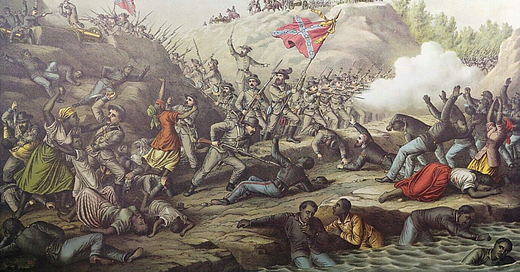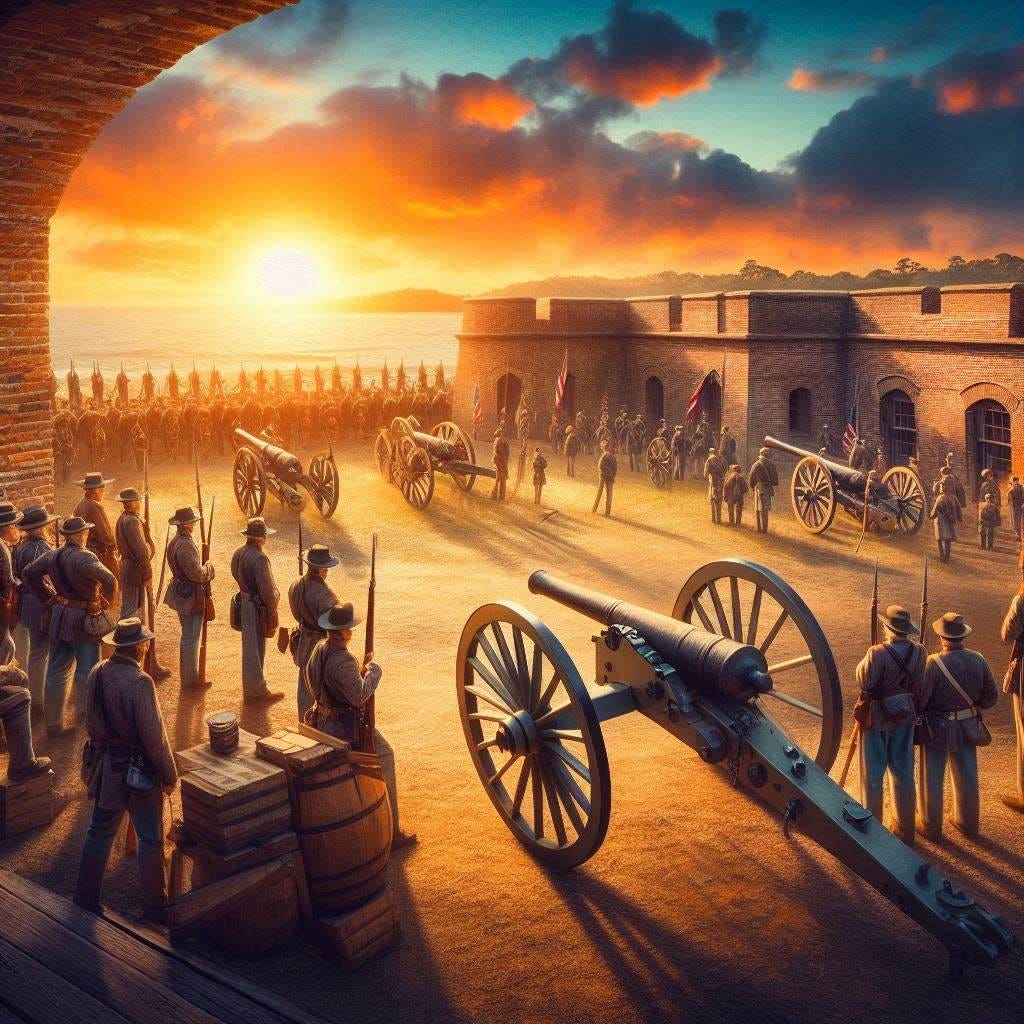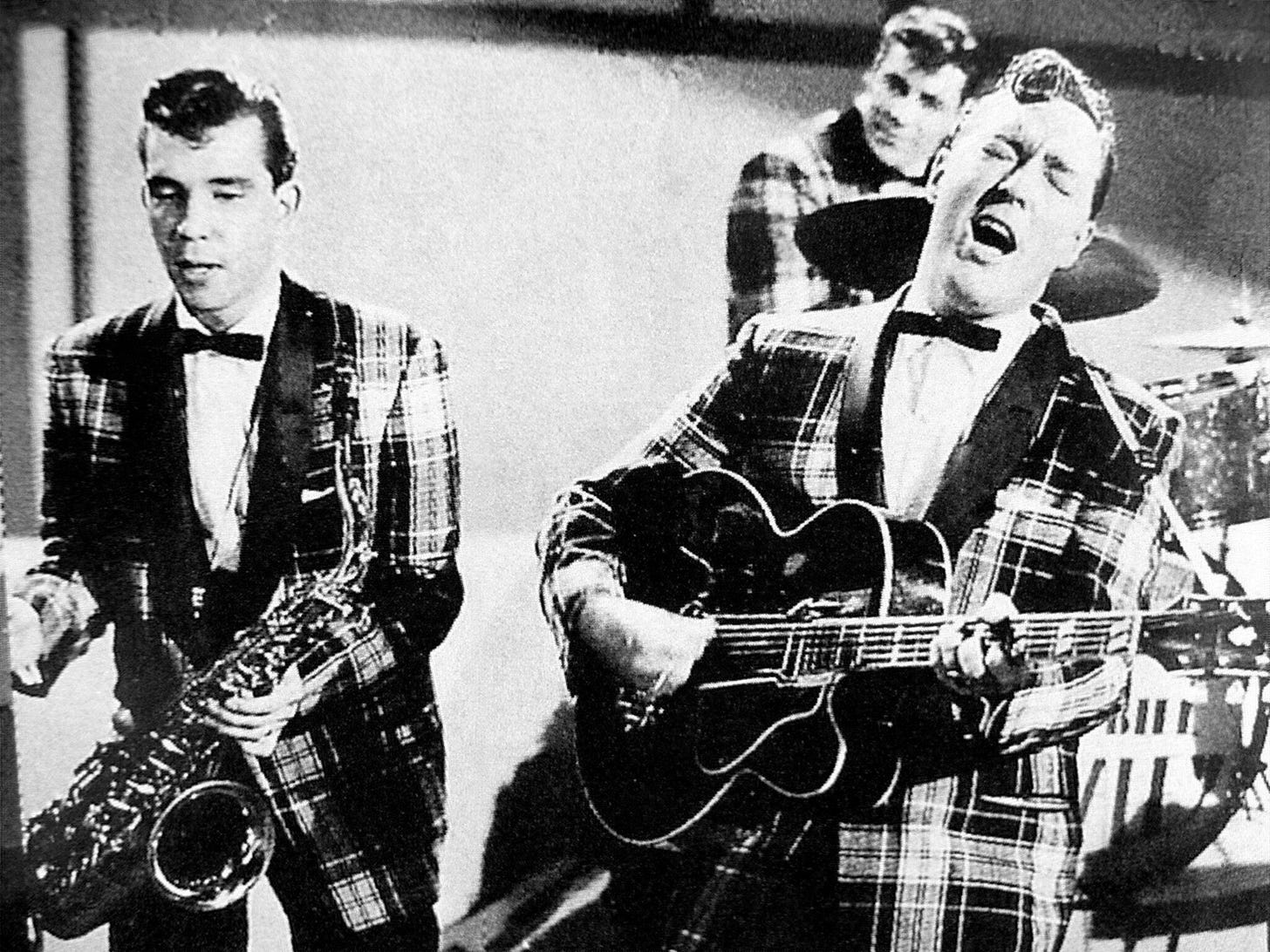The Mysteries of History (April 12 Edition)
Galileo Falsely Accused; Civil War Begins; Fort Pillow Massacre; FDR Dies; Rock Around the Clock
“Those who cannot remember the past are condemned to repeat it.” — Spanish-American philosopher George Santayana, 1905
“He is free to evade reality, he is free to unfocus his mind and stumble blindly down any road he pleases, but not free to avoid the abyss he refuses to see.” — Alice O’Connor, 1961
1633 — Galileo Goes On Trial
image generated using Bing Image Creator
Galileo Galilei (1564-1642) was brought to trial on this date in 1633 on the charge of heresy (which has been defined as, “belief or opinion contrary to orthodox religious (especially Christian) doctrine”). He was innocent. He was right. Even if he was wrong and was just uttering an opinion, it did not warrant the way he was mistreated.
His “crime”? Agreeing with Copernicus (and others) that the earth revolves around the sun, rather than vice versa.
For more information, see the previous articles 1633 — Galileo Charged as a Heretic here (February 13 Edition of this series) and 1642 — Galileo Dies here (January 8 Edition)
Questions: Are there any modern-day “Galileos” (those who are persecuted for speaking the truth)? Would you be willing to do that?
1861 — Civil War Begins With a Bang
public domain images from wikimedia commons
The following is part of what I wrote about the Beginning of the Civil War in my book Still Casting Shadows: A Shared Mosaic of U.S. History — Volume 1: 1620-1913:
“‘A house divided against itself cannot stand’. I believe this government cannot endure permanently half slave and half free.”—Abraham Lincoln, 1858
“Why, if a kingdom becomes divided against itself, that kingdom cannot stand; and if a house becomes divided against itself, that house will not be able to stand.”—Mark 3:24, 25
“I have been told I was on the road to hell, but I had no idea it was just a mile down the road with a dome on it.”—Abraham Lincoln
“How many times must the cannonballs fly, before they’re forever banned?”—from the song “Blowin’ in the Wind” by Bob Dylan
It must be admitted that, if nothing else, the South had it all over the North when it came to picking military leaders with flashy names. Compare P.G.T (Pierre Gustave Toutant) Beauregard, Thomas “Stonewall” Jackson, Robert E. Lee, J.E.B. “Jeb” Stuart, Jubal Early, James Longstreet, and Braxton Bragg (for example) with Hiram Ulysses Grant (U.S. Grant’s real name), George McClellan, Joseph Hooker, and John Pope, et al. But elan, panache, blood-curdling yells, and fancy hats do not win wars. Nor do chivalry, tradition, and mystique.
In this case, not even cannier and more daring leadership always won the day. The South was no match for the north’s superior numbers and equipment. The industrial north had 21 million inhabitants; the agrarian South had a total of nine million, four million of whom were slaves.
Beauregard fired on Fort Sumter, on Charleston Harbor in South Carolina, on April 12th. The venue was fitting, as South Carolina had been the first state of the eventual eleven to secede, and the only one to do so in 1860, before Lincoln had even begun his term in the White House. This attack was answered three days later with Lincoln’s call for 75,000 military volunteers. An official declaration of war followed on the 4th of July, after the convening of Congress in special session.
Aging general Winfield Scott considered Robert E. Lee the best officer in the U.S. Army. At Scott’s urging, Lincoln offered Lee field command of the Union Army. Lee considered slavery “a moral and political evil.” He also strongly preferred that the country remain united. In this vein, Lee wrote in January of this year: “The framers of the Constitution never exhausted so much labor, wisdom, and forbearance in its formulation, if it was intended to be broken up by every member of the [Union] at will.…It is idle to talk of secession.”
Nevertheless, when Lee’s home state of Virginia decided on seceding, Lee said “I cannot raise my hand against my birthplace, my home, my children.” April 18th, the same day he was offered command of the Union forces, Virginia seceded. Lee informed Scott that not only did he decline the offer of Union command, but he also resigned from the army. Scott replied: “You have made the greatest mistake of your life, but I feared it would be so.”
Although most southern officers decided as did Lee, some of them remained true to the Union, such as David “Damn the Torpedoes” Farragut of Tennessee.
In his classic work “The Life of Billy Yank: The Common Soldier of the Union,” Bell Irvin Wiley wrote of the war’s beginning:
The South’s attack on Fort Sumter fell like a thunderclap on the country north of Dixie. True, there had been talk of war, especially since the secession of the cotton states and the organization of the Southern Confederacy, but the agitators, consisting mainly of politicians, journalists, preachers and reformers, many of whom were on the make, were relatively few. A substantial portion of the population still hoped for a peaceful solution of the sectional crisis even after Jeff Davis set up his rival government.
Fort Sumter changed all this. The flag had been affronted. Men wearing the American uniform had been forced by hostile fire to surrender a Federal fort and march out in acknowledged defeat. And with that humiliating incident peaceful secession lost all respectability. The die was cast.
The secession of the southern states, and the exclamation mark on this at Fort Sumter had rearranged the letters in the national name from United States to Untied States. The Union could not, would not, stand for that. In his initial call for volunteers, Lincoln requested three months service only. Most Ameri cans thought the Civil War would end after one gigantic battle, the winner marching on to take the loser’s capital, in either Washington, D.C. or Richmond, Virginia. Before long, though, it became apparent that that thinking was erroneous. The requested service time for Union military volunteers increased to three years, as can be seen in the poster below.
Very few expected the war to last as long as it did. But the war dragged on, and descended into new depths of atrocity as a panoply of new technology was used in war for the first time: Trains for transporting troops and equipment; telegraphs for communication; ironclad ships as a replacement for “old-fashioned” wooden ones; hot-air balloons for reconnaissance missions; land mines; hand grenades; the use of trenches, or foxholes; submarines; and, worst of all, the paradigm of “all-out war.” Hostilities were not limited to enemy combat ants. Their foodstuffs and material things were also destroyed, causing untold misery and suffering to enemy soldiers, and also to millions of civilians on both sides—and even to those who declined to take sides.
Fittingly, perhaps, Mark Twain was on the last Mississippi River steamboat upriver before the Union blockade at Memphis, Tennessee that began in May of this year.
The rebels were not firing squirrel guns and blunderbusses at the fort; they launched 4,000 rounds from 10-inch Columbiads and 8-inch Brooke rifles as well as 42-pounders launched from mortar barrels, additionally “hot shots” (heated cannonballs) designed to set its target aflame).
Fort Sumter was surrendered the following day, and the day after that President Lincoln put out the call for 75,000 volunteers to put down the southern insurrection. Animosities only escalated from there. 620,000 dead soldiers later, the Nation-sundering and family-plundering war was finally brought to an end.
image generated using Bing Image Creator
Questions: Which was the first State to secede from the Union. What non-southern State joined South Carolina, Mississippi, Alabama, Georgia, Florida, and Louisiana in severing ties with the United States? For how long had the southern States been contemplating breaking off from the rest of the Country? What threat had they made relative to the 1860 Presidential election? Which political party was at that time the anti-slavery party? Where and when was that party founded?
1864 — Fort Pillow Massacre
public domain image from wikimedia commons
The following is what I wrote about the Fort Pillow Massacre in my book Still Casting Shadows: A Shared Mosaic of U.S. History — Volume 1: 1620-1913:
“The dead cannot cry out for justice; it is a duty of the living to do so for them.”—Lois McMaster Bujold
Two of the most hideous massacres in American history occurred this year. On April 12th, Fort Pillow, a Union fort near Memphis, Tennessee, manned primarily by black soldiers, surrendered to Confederate forces under General Nathan Bedford Forrest. Not only were hundreds of soldiers who had sur rendered killed, but even those laying wounded in the hospital were shot in their beds. Women and children present at the fort were not exempt from the brutality, either, many of whom were methodically slaughtered. General For rest—as Generals usually are—was exonerated from any wrongdoing in the matter. He later became “grand wizard” of the Ku Klux Klan
More than half of the soldiers at the isolated outpost on the banks of the Mississippi River were, as mentioned, black. N.B. Forrest’s past and future plainly implicate this military adventure to be racially motivated.
Questions: Were all southern soldiers racially prejudiced? Were all northern soldiers free of racial prejudice? What prevented Forrest’s soldiers from resisting his sadistic treatment of the black soldiers and their families?
1945 — FDR Dies
public domain images from wikimedia commons
The following is what I wrote about FDR’s death in my book Still Casting Shadows: A Shared Mosaic of U.S. History — Volume 2: 1914-2006:
Franklin Delano Roosevelt had died April 12th, shortly after beginning his fourth term as President. His post as President was taken over by Missourian Harry Truman. Within three weeks of FDR’s death, Italy’s Mussolini and Germany’s Hitler were also dead. Apparently being the type of person to wear both suspenders and a belt, Adolf Hitler poisoned and then shot himself on April 30th. And so it was that the man who brought a “New Deal” to America was dead, and the diabolical psychopath who had brought destruction and devastation to Europe was, also. Italy’s fascist leader Mussolini was arrested at the end of April. “Il Duce” and his mistress were then lynched. By the end of the year, another key figure in the war, George Patton, would be dead. FDR had been the only President to be elected to more than two terms of office. He had died shortly after his fourth term began. To prevent a virtual “reign” of power by any one administration, the 22nd Amendment to the Constitution was ratified on February 26th, 1951, limiting a president to two consecutive terms in office.
FDR died in Warm Springs, Georgia, in 1945, shortly after beginning his unprecedented and not-to-be-repeated fourth term (he had completed three full elected presidential terms in office, and was in the early stages of the fourth).
At the time of his death from a cerebral hemorrhage, Franklin was in the company of a woman not his wife, Lucy Mercer Rutherfurd (born Lucy Page Mercer, 1891–1948). FDR and Mercer had carried on a long-lasting adulterous relationship starting before she was married and recommencing after she became a widow. Many family members were aware of their relationship and either kept it quiet or actively supported it.
When the first lady Anna Eleanor Roosevelt (1884-1962) was informed of her husband’s (also distant cousin’s) death, she relayed the news to their four sons, who were all on active duty (World War 2 was still raging) via telephone. She then informed the Vice President, Harry Truman, who would take up the mantle as leader of the Country. Truman asked her if there was anything he could do for her. Her reply to him was reportedly, “Is there anything we can do for you? For you are the one in trouble now.”
And he was, in the sense that he then had to decide what to do about the nuclear weapons then being designed, of which he had no clue until he became President.
Images of Anna Eleanor Roosevelt from child to advanced age from wikimedia commons
Questions: Why did many, even family members, condone FDR’s dalliances with Mercer? Why did FDR keep Truman in the dark about The Manhattan Project?
1954 — Bill Haley Rocks Around the World
public domain image from wikimedia commons
Bill Haley and His Comets had other hit records before “Rock Around the Clock,” such as “Go, Cat, Go” from 1953 and their 1954 cover of Big Joe Turner’s “Shake, Rattle, and Roll.”
“Rock Around the Clock” was also first released in 1954. It was only a moderate success at the time. However, the next year (1955, if you’re not an expert at math), the song was featured in the 1955 film “Blackboard Jungle” featuring Glenn Ford as Richard “Daddy-O” Dadier, Anne Francis, Sidney Poitier, and Vic Morrow (among others, of course).
The Comets then re-released “Rock Around the Clock,” which is possibly the song that most embodies and best represents 1950s rock and roll.
This time around, their signature song reached #1 on the charts and remained there for eight weeks; it became the first record to sell over a million copies in Britain and Germany (in addition to America).
Bill Haley and His Comets were the first super-popular rock and roll band, catapulting the new genre to the top of the pops, supplanting jazz and the previous Sinatras, Comos, Crosbys, and their ilk. Rock and Roll was here to stay!
The session guitarist who played the solo on Rock Around the Clock, Danny Cedrone, was paid a whopping $21 for it (the equivalent of $248 today), and died from a fall at his home prior to the song becoming a huge hit.
Questions: Which rock artists from the 1950s are you familiar with? Which is/are your favorite[s]? What happened to the Comets after their heydey?
Read about “The Secret Lives of Kids” here.













